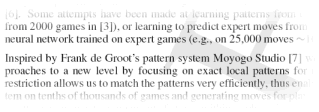|
|
||||
|
|
MICROSOFT RESEARCH DUPLICATING MOYOGO'S PRINCIPLES |
|||
|
Their preliminary paper. Their cover letter, in which they rightly assume that Moyo Go outperforms theirs. I have made the mistake of disclosing too much about how Moyo Go Studio works, but fortunately I have not explained how the current system of harvesting & learning works. I used "Bayesian" learning before (and I alluded to it on the Go programmers' mailing list), but that is a cumbersome method. This is why I can use a million games for the harvesting phase and half a million for the learning phase, and Microsoft Research only a paltry 20,000, and this is why Microsoft's three researchers achieve 26% pro-prediction, and Moyo Go Studio about double that (I will publish results as soon as I am ready with the first release and its associated work). The fact that they admit that Moyo Go's pro-prediction is the best in the world (they are second and Erik van der Werff's system is third) is the best possible advertising for Moyo Go. Moyo Go is the most accurate, reliable, powerful, quick, easy program to show Fuseki, Joseki & good shape variations and how they occur in actual games. It's silly of them to claim to have taken my approach to "a whole new level", as they obviously haven't gotten a clue as to what my approach constitutes, neither are their results as good as mine. |
|
|||
|
As happens often, the
real* inventors often don't get the credit: http://www.theregister.co.uk/2005/07/04/silicon_chess/
mentions how
"Researchers at Microsoft's labs in Cambridge have made some
improvements to computer Go".. |
||||

 It is a good sign,
when Microsoft dedicates three of their researchers on duplicating
Moyo Go's system of pattern recognition and move prediction, to try to
reach the same level of Fuseki, and Joseki, and "Good
Shape" pattern expertise as MoyoGo has.
It is a good sign,
when Microsoft dedicates three of their researchers on duplicating
Moyo Go's system of pattern recognition and move prediction, to try to
reach the same level of Fuseki, and Joseki, and "Good
Shape" pattern expertise as MoyoGo has.